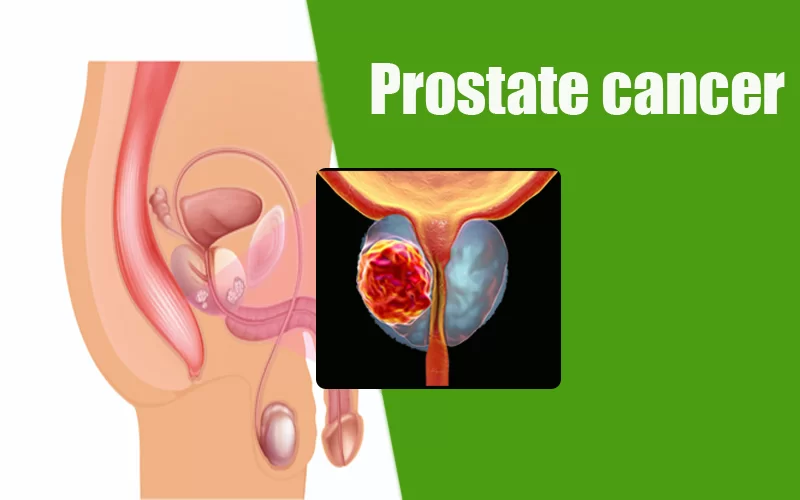Prostate Cancer:
Prostate cancer is a form of cancer that develops in the prostate, a small walnut-shaped gland in men. It often grows slowly and may not cause noticeable symptoms initially. Regular screenings and early detection are crucial for effective management.
The Prostate:
The prostate is a small, walnut-sized gland located beneath the bladder in men. It plays a role in the production of seminal fluid that nourishes and transports sperm. Issues such as enlargement or cancer can affect prostate health and may require medical attention.

Warning Signs:
Different people have different symptoms for prostate cancer. Most men do not have symptoms at all.
If you have any of the following symptoms, be sure to see your doctor right away—
- Difficulty starting urination.
- Weak or interrupted flow of urine.
- Urinating often, especially at night.
- Trouble emptying the bladder completely.
- Pain or burning during urination.
- Blood in the urine or semen.
- Pain in the back, hips, or pelvis that doesn’t go away.
- Painful ejaculation.
Keep in mind that these symptoms may be caused by conditions other than prostate cancer.
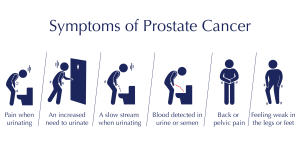
Types of Prostate Cancer:
Almost all prostate cancers are adenocarcinomas. These cancers develop from the gland cells in the prostate (the cells that make the prostate fluid that is added to the semen).
Other types of cancer that can start in the prostate include:
- Small cell carcinoma (small cell neuroendocrine carcinoma)
- Other neuroendocrine tumors (including large cell carcinoma)
- Transitional cell carcinoma
- Sarcomas
These other types of cancer are rare. If you are told you have prostate cancer, it is very likely to be an adenocarcinoma.
Some prostate cancers can grow and spread quickly, but most tend to grow slowly. To learn more, see the information on prostate cancer grades in Tests to Diagnose and Stage Prostate Cancer.
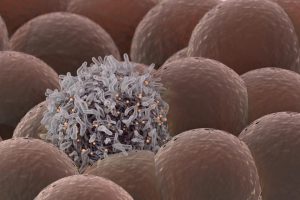
Possible Pre-Cancerous Conditions of the Prostate
Some research suggests that prostate cancer might start out as a pre-cancerous condition in some cases. These conditions are sometimes found when a man has a prostate biopsy (removal of small pieces of the prostate to look for cancer).
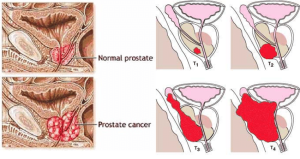
Prostatic intraepithelial neoplasia (PIN)
In PIN, the prostate cells don’t look normal when seen with a microscope, but the abnormal cells don’t look like they are invading into other parts of the prostate (like cancer cells would). PIN is not cancer, but it can sometimes lead to a higher risk of prostate cancer.
Based on how the patterns of cells look, PIN is classified as either:
- Low-grade PIN if the patterns of prostate cells appear almost normal, or
- High-grade PIN if the patterns of cells look more abnormal
Low-grade PIN is not thought to be related to a man’s risk of prostate cancer.

If you have high-grade PIN, you may have a higher risk of developing prostate cancer over time. However, most often high-grade PIN does not turn into cancer.
Proliferative inflammatory atrophy (PIA)
In PIA, the prostate cells look smaller than normal, and there are signs of inflammation in the area. PIA is not cancer, and it’s not yet clear if PIA might lead to high-grade PIN or prostate cancer.
For more on non-cancer conditions that might be seen on a prostate biopsy, including PIN, see Tests to Diagnose and Stage Prostate Cancer.
Stages Of Prostate Cancer:
Prostate cancer is typically staged using the TNM system, which considers the tumor size, lymph node involvement, and the presence of metastasis. The stages are as follows:
- Stage I: The cancer is confined to the prostate and is too small to be felt during a digital rectal exam.
- Stage II: The tumor is still within the prostate but may be larger. It remains localized and hasn’t spread to nearby tissues.
- Stage III: Cancer has spread beyond the outer layer of the prostate and may involve nearby tissues, but it hasn’t reached distant sites.
- Stage IV: The cancer has spread to nearby tissues, lymph nodes, or other organs like bones. This is the most advanced stage of prostate cancer.
Understanding the stage is crucial in determining the appropriate treatment and assessing the prognosis for individuals diagnosed with prostate cancer.
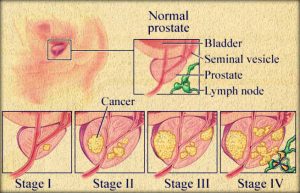
Prevention:
While there’s no guaranteed way to prevent prostate cancer, certain lifestyle choices and habits may contribute to reducing the risk:
- Healthy Diet: Consume a diet rich in fruits, vegetables, and whole grains. Limit intake of red and processed meats.
- Regular Exercise: Engage in regular physical activity, which is associated with a lower risk of prostate cancer. Aim for at least 150 minutes of moderate exercise per week.
- Maintain a Healthy Weight: Obesity is linked to an increased risk of prostate cancer, so maintaining a healthy weight through a balanced diet and exercise is beneficial.
- Limit Alcohol Consumption: Excessive alcohol intake has been associated with an increased risk of prostate cancer. If consumed, it should be in moderation.
- Quit Smoking: Smoking is linked to a higher risk of aggressive prostate cancer. Quitting smoking has numerous health benefits, including reducing the risk of cancer.
- Regular Check-ups: Regular prostate screenings, including PSA (prostate-specific antigen) blood tests and digital rectal exams, can aid in early detection and intervention.
- Consult with Healthcare Providers: Discussing individual risk factors, family history, and potential preventive measures with healthcare providers can offer personalized guidance.
Conclusion:
In conclusion, prostate cancer is a prevalent form of cancer among men, typically originating in the prostate gland. Regular screenings, early detection, and an understanding of risk factors are essential in managing this condition effectively. Treatment options range from active surveillance for slow-growing cases to surgery, radiation therapy, and hormone therapy for more aggressive forms. Prostate cancer awareness, coupled with advances in medical research and personalized treatment approaches, continues to shape a comprehensive strategy for prevention, diagnosis, and treatment, ultimately improving outcomes and quality of life for those affected.

